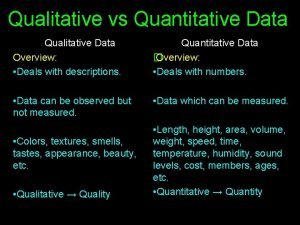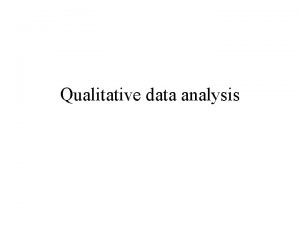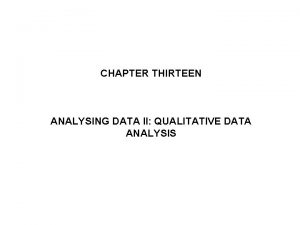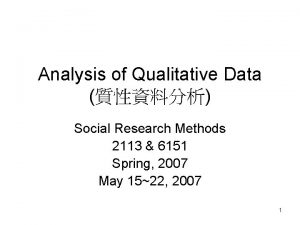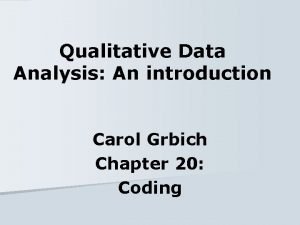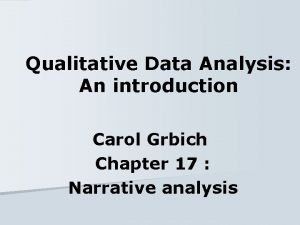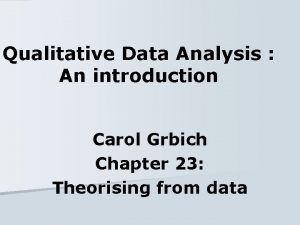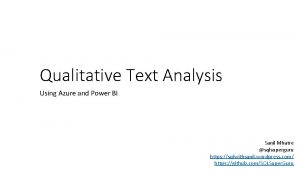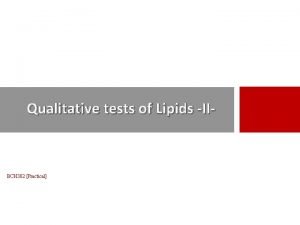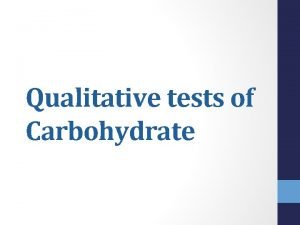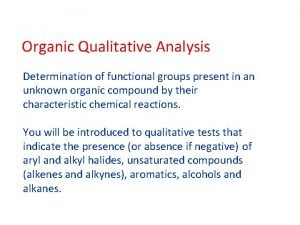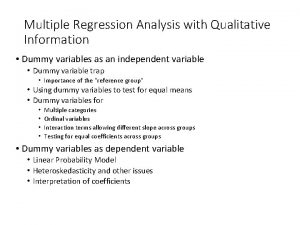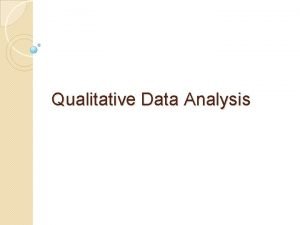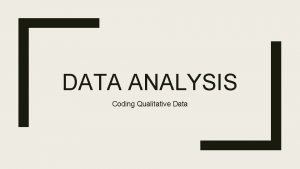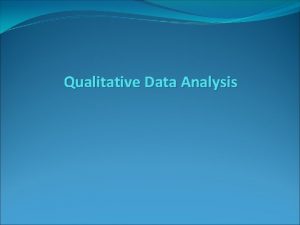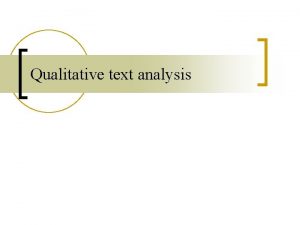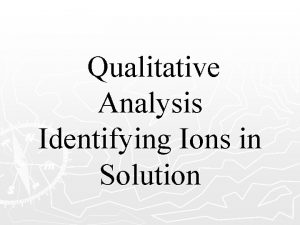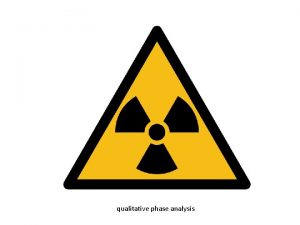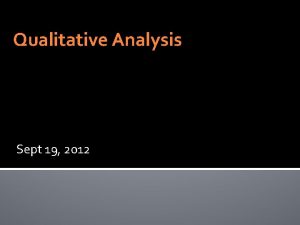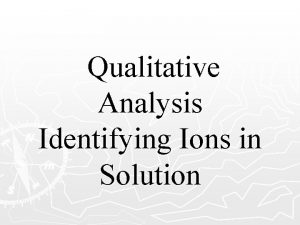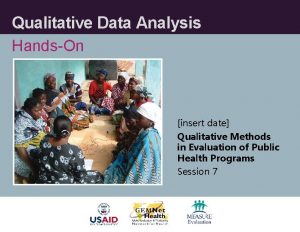Qualitative Data Analysis What is Qualitative Data Qualitative




















- Slides: 20

Qualitative Data Analysis

What is Qualitative Data? • Qualitative data refers to the meanings, concepts, definitions, characteristics, metaphors, symbols and descriptions of things”, whereas quantitative research is concerned with “counts and measures of things” (Berg, 2001: 3) • Qualitative data is therefore often ‘deeper’ than quantitative data, which is more focused on one particular relationship or phenomenon

Where is a Qualitative Approach Appropriate? • There are particular instances where a qualitative approach may be more appropriate than a quantitative approach, for example: – Exploring an under-researched or new issue – Exploring a complex issue where a large (or unknown) number of factors may be involved – Where the researcher wants to know the participant’s feelings, emotions and detailed experiences about the phenomenon

Thematic Analysis & Discourse Analysis • Thematic Analysis – a method of analysing qualitative data that identifies recurring patterns within the date – forming themes from codes and categories • Discourse Analysis – a method of analysing qualitative data that considers the type, structure, syntax and situated meanings of the words/sentences that make up the data

Thematic Analysis • “A method for identifying, analyzing and reporting patterns with data” (Braun & Clarke, 2006: 79) • A way of organizing raw (unanalyzed) data into distinct themes • A theme represents a level of patterned response or meaning within a dataset – a recurring trend in the way in which the respondents talk about something • The importance of a theme is not dependent on size but rather in how well it helps to answer the research question

Step 1: Familiarize yourself with the data and context • Read and re-read the data, ‘get to know’ the data and what each respondent is saying • Know the context – Bournemouth, tourism sector during Covid, UK funding/policies, etc. • Note down any initial ideas – doesn’t have to be structured/neat at this point!

Step 2: Start to form initial codes • Once you have familiarized yourself with the data, systematically go through each sentence and code those that you found potentially interesting to your analysis • They don’t have to directly answer a research question – just use your judgment about whether they *might* help in any way


What is a Code? • “the most basic segment, or element, of the raw data that can be assess in a meaningful way regarding the phenomenon” (Boyatzis, 1998: 63) • Codes are a way of condensing a sentence (or group of sentences) into a meaningful synopsis of its direct or indirect meaning – Summative Code – a code that ‘sums up’ what the sentence/group of sentences is about, e. g. a minute summary – Evocative Code – a code that highlights what meaning(s) the sentence evokes, but doesn’t necessarily say directly

From Codes to Categories • Over time and during repeated coding, you will end up with many, many codes • These codes can then be grouped into categories (also called ‘ 2 nd order codes or axial codes) • Categories are like a label that describes the codes within the category, are therefore by necessity broader than the codes, which are quite specific • E. g. if your codes were – ‘Anger about X’, – ‘Fear over the consequences of X’ – Surprise that X happened’ Then these could all be grouped in the category ‘Emotions concerning X’

From Categories to Themes • In a similar way that codes can be grouped into categories, we can group categories into themes • Themes are broader than categories and directly relate to the research question (e. g. a theme for your Assignment 1 may be something like ‘reasons for visiting Bournemouth’, ‘obstacles for tourism companies’

Step 3: Search for Themes • Once your codes have been categorised (and remember not all will fit into a category – they can be under ‘miscellaneous’), you can start to search for themes • Read through your codes and see does anything ‘jump out’ at you – an obvious pattern or relationship between the categories – see if you can form a theme from them. Keep repeating the process until you think you are able to answer the research question quite well

Coding is iterative • Coding is not a sequential, step by step process (although I have tried to simplify it here!) • You can identify a category or theme and then go back to find more codes that may fit that category/theme (or even adapt the category/theme slightly to fit better)

Step 4: Review the Themes • Is there enough data to support each theme? • Does a theme need to be broken down into subthemes? – The data within each theme should stick together quite meaningfully • Do two (or more) themes need to be merged together? – There should be clear and identifiable distinctions between themes (Braun & Clark, 2006)

Coding is ‘Messy’! • There will be many times where you feel that you have too many codes, not enough categories, and that your analysis is becoming very messy • KEEP GOING – this is common for many qualitative analyses; take a break, you will start to see patterns emerging eventually

Coding in Practice • The software NVivo allows a researcher to code qualitative data, assemble the codes into categories and then themes • However, given the short timeframe (and to allow you to practice theory behind coding), you can also try to do your coding manually for Assignment 1 • Use MS Word and use the highlighter function to code the workshop data – different colours can represent different codes (take a note of them). Or, if preferred, print out the workshop data and use different coloured pens to underline/draw arrows to different sentences/codes (the old-old fashioned way!)

Inductive Coding vs. Theoretical Coding • Inductive coding is when themes built from the data are strongly linked to the data itself – the researcher tries to ‘forget’ about preconceived ideas when they analyse the data • Theoretical coding is when themes may be somewhat established before the analysis begins (such as in your Assignment 1)

Assessment Brief Bournemouth is a resort town on the south coast of England (https: //www. bournemouth. co. uk/). It was significantly adversely impacted during the Covid-19 pandemic and the number of tourists remains low. Your team has been hired by Bournemouth City council to re-analyse data that had been collected as part of an Economic and Social Research (ESRC)funded project in 2014. Your brief is to focus the analysis around the use of wellbeing, health and ‘feelgood’ strategies in hospitality organisations in the key areas of marketing, operations and managing staff. Using either thematic analysis or discourse analysis, produce a summary of your analysis and make recommendations to the council on how they can stimulate their hospitality organisations with the aim of revitalising the tourism sector in Bournemouth.

Using Thematic Analysis in your Assessment • You already have been given a headstart on how to analyse the data – you need to focus on ‘wellbeing, health and ‘feelgood’ strategies in hospitality organisations in the key areas of marketing, operations and managing staff’. • Before you start, think about and write down your research question – look at the assignment brief for what type of RQ will help you fulfil the aims of the assessment

• “To me, it’s so inherent in all tourism and I feel that a lot might come down and do some cycling while they’re here, but it’s not ALL what they’re come down for, they’ll do some shopping and some sightseeing. • It’s trying to make sure that whole package balances”. • Husband might want to do one thing and the wife might want to do something else. • Going on a holiday with family or your partner, wellness means something different for everyone. • Man might want to go off cycling for two days and the woman might want to go to the spa for two days. • The reason for going on holiday is to go together so this becomes difficult. ”
 Instruments in quantitative research
Instruments in quantitative research What is qualitative data
What is qualitative data Principles of qualitative data analysis
Principles of qualitative data analysis Data analysis qualitative and quantitative
Data analysis qualitative and quantitative Thematic analysis in qualitative research
Thematic analysis in qualitative research Qualitative coding examples
Qualitative coding examples Characteristics of a qualitative research design
Characteristics of a qualitative research design Data
Data Bad research questions
Bad research questions Qualitative research
Qualitative research Qualitative data analysis
Qualitative data analysis Qualitative data analysis
Qualitative data analysis Qualitative data analysis
Qualitative data analysis Chapter 10 qualitative data analysis
Chapter 10 qualitative data analysis Content analysis is a type of secondary data analysis
Content analysis is a type of secondary data analysis Holistic research approach
Holistic research approach Power bi text analytics
Power bi text analytics Qualitative test for lipid
Qualitative test for lipid Carbohydrates qualitative test
Carbohydrates qualitative test Qualitative analysis of organic functional groups
Qualitative analysis of organic functional groups Multiple regression analysis with qualitative information
Multiple regression analysis with qualitative information

